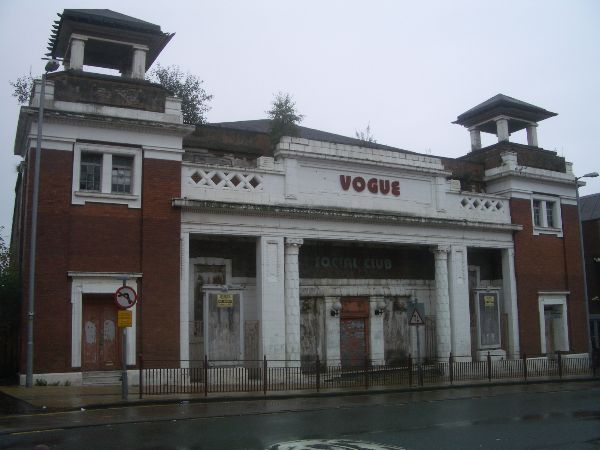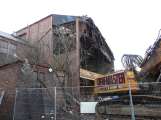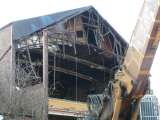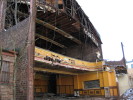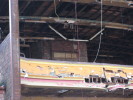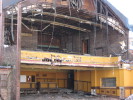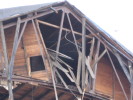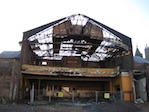The La Scala
cinema, in Keith
Street, Hamilton, opened in 1921, to the designs of architect James
McKissack - also designer of the La Scala,
Sauchiehall Street (1912), the Kingsway
(1929) in Cathcart, the Riddrie
(1938), the Mecca
(1933), and many more. It was originally opened for the small circuit
of around a dozen Scottish cinemas run by Thomas Ormiston.
The Ormiston cinemas were sold to Gaumont in 1928, but the Hamilton La
Scala was not given the circuit name until 1950. Closure as a cinema
came only ten years later, which seems inevitable given the cinema’s
very close proximity to the much more modern ABC and Odeon
halls in Hamilton, opened in 1931 and 1938 respectively.

Exterior poster board

Pillar detail

Foyer view

Automaticket detail |
Following the
end of films, the La Scala was converted for bingo use as the Vogue. It
continued on bingo for some time, being B-listed
by Historic Scotland as far back as 1979, before finally closing in
1997.
It has been derelict since then, and after a period of
uncertainty, is now owned by South Lanarkshire Council. In 2005,
planning permission was granted for a developer which involved
demolition of the auditorium area for restaurant and leisure use,
although the fašade will be retained. It should be noted, however, that
similar plans involving the demolition of the auditorium and retention
of the fašade were approved in 1999 and 2001, neither of which came to
fruition.
In the meantime, 8 years of dereliction has not been kind to the
structure, and water damage from both burst pipes and ceiling leaks
have resulted in failure of both floors and ceilings, mostly in the
foyer and rear stalls area. Work to strip out asbestos has also
resulted in the loss of most of the auditorium wall covering, and the
ceiling between the barrel-vaulted ribs.
The exterior includes an unusual feature of two tall, free-standing
poster boards, on either side of a recessed portico entranceway. This
is flanked by tall Egyptian-style pillars, decorated with pattern of
overlapping scales, similar to those McKissack had utilised for the
entrance of his (unrelated) La Scala in Glasgow 9 years previously.
Marble stairs, now sadly fragmentary, led from the street to a central
exterior paybox, situated in the middle of the recessed portion of the
facade, with doors on either side leading to the main foyer regions.
The bright, faience finish of the portico area of the fašade was
contrasted by the pair of red brick towers at either corner. These were
topped by open wooden “bell towers”, which were themselves capped with
pyramid-shaped roofs, joined along the top of the full width of the
fašade with open balustrades and a central stone name panel. |
The exterior paybox looking directly onto the street was something
McKissack would return to for another project with limited foyer space,
namely the 1929 Kingsway.
Other similarities with this later cinema include the foyer spaces
being wider than they are deep, and featuring high, tapering ceilings.
In addition,
both cinemas did not have upper foyer areas – instead,
narrow stairs on each side of the building led directly to the front
balcony,
then continued up to the rear balcony. The balcony itself extends
back and the main foyer is directly below it. The auditorium,
however,
bore little resemblance to the Kingsway, apart from the proscenium
opening, to which we shall return shortly.
The La Scala featured a long, narrow auditorium, with straight
sidewalls and a single, straight-fronted balcony. The ceiling was a
fairly plain, barrel-vaulted affair, with plaster ribs joining the
pilasters on the sidewalls at each side. Above the balcony, the ceiling
adopted a shallower curve.
There were few decorative features on either the sidewalls or ceiling,
bar some simple capitals at the top of the sidewall pilasters, and
small, geometric ventilation grilles along the centre of the ceiling.
These grilles also featured on the underside of the balcony, in the
rear stalls area. These particular grilles
were situated in three
square, coffered recesses on the ceiling under the balcony, which were
also lined with decorative cornicing. Similar cornicing adorned most of
the junction between wall and ceiling in the rear stalls area.
The stairway on
the front left hand side of the balcony was a later
addition for bingo, but was done in a very sympathetic manner,
continuing the decoration and curve of the original balcony front.
The proscenium was a prototype of a design McKissack was to reuse in
several different locations in later designs – a thickly bordered arch
with flat sides, curving over at the top. In most of his later
examples, the border area was ribbed, but here it was plain. Instead,
the sides here featured richly ornate pillars with foliage decoration,
whilst the whole arch is surmounted by an ornate plasterwork cartouche
– a bulbous, heart-shaped affair with foliage surround, topped with a
cherubic head. |
View
to front auditorium

View to rear auditorium

Barrel-vaulted ceiling

Proscenium cartouche detail
|
His later prosceniums of a similar shape omitted the
cartouche and side pillars, in favour of the aforementioned ribbed
effect – surviving examples including the Riddrie and the Kingsway,
although the latter has been largely destroyed by water ingress after
many years of dereliction:
|
La Scala Proscenium (1921) |

Kingsway Proscenium (1929) |

Riddrie Proscenium (1938) |
A small projection room was located at the back of the balcony, with a
rewinding room directly behind it. Both had a fire exit leading out
onto the roof space, directly behind the open latticework balustrades
at the top of the facade. Above the right foyer side entrance,
overlooking the street, was a large office and storeroom.

Poster 'room'

Poster detail |
Perhaps the
most unusual and interesting feature in the building is one
that very few people would have ever seen during its working life.
A
ladder outside the projection booth led up into the roofspace,
officially just to give access to change lightbulbs and check
the
ventilation system.
However, at some point a projectionist had used
this space, almost a small room between the panels hiding the
ventilation shafts, as a private getaway space. They had decorated the
space on either side with a variety of different circus and variety act
posters.
One of them is titled 'Bostock and
Wombwells Gigantic Combined Show';
which was touring until 1931, dating the posters to that time at the
very latest. |
Many thanks to
South
Lanarkshire Council, and in particular Stuart Hodge and his colleagues,
for the opportunity to survey the building.
 |
Click
here for
a full internal photo survey, circa October 2005.
An exterior picture from 1993 is here,
courtesy of Chris Doak.
|
|
